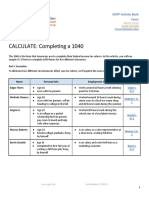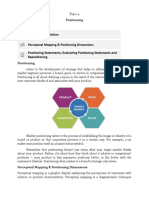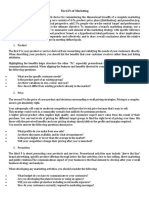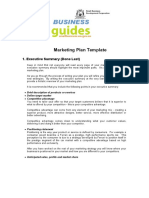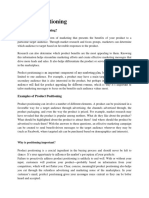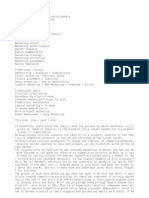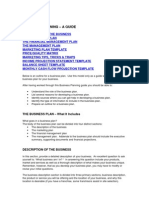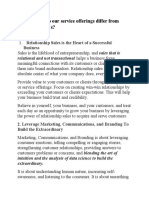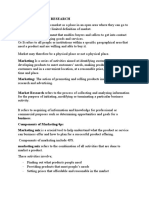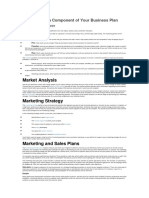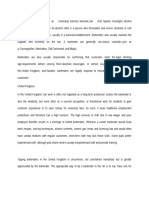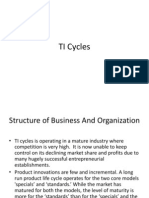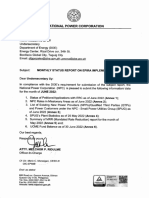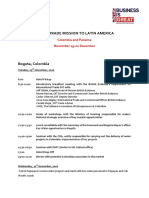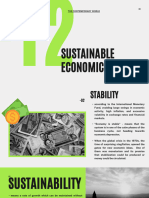0 ratings0% found this document useful (0 votes)
25 viewsPositioning: Rommel Erwin Q. Anca, LPT, Maed
Positioning: Rommel Erwin Q. Anca, LPT, Maed
Uploaded by
Acna RomeThis document discusses positioning and perceptual mapping in marketing. It defines positioning as developing a strategy to influence how customers perceive a brand compared to competitors. Perceptual mapping uses diagrams to visually display customer perceptions of product characteristics. Positioning statements summarize the target market and key differentiators to communicate a brand's desired positioning. The document provides examples of effective positioning statements and discusses evaluating and potentially repositioning statements over time as markets and customers change.
Copyright:
© All Rights Reserved
Available Formats
Download as PPTX, PDF, TXT or read online from Scribd
Positioning: Rommel Erwin Q. Anca, LPT, Maed
Positioning: Rommel Erwin Q. Anca, LPT, Maed
Uploaded by
Acna Rome0 ratings0% found this document useful (0 votes)
25 views13 pagesThis document discusses positioning and perceptual mapping in marketing. It defines positioning as developing a strategy to influence how customers perceive a brand compared to competitors. Perceptual mapping uses diagrams to visually display customer perceptions of product characteristics. Positioning statements summarize the target market and key differentiators to communicate a brand's desired positioning. The document provides examples of effective positioning statements and discusses evaluating and potentially repositioning statements over time as markets and customers change.
Original Title
POSITIONING
Copyright
© © All Rights Reserved
Available Formats
PPTX, PDF, TXT or read online from Scribd
Share this document
Did you find this document useful?
Is this content inappropriate?
This document discusses positioning and perceptual mapping in marketing. It defines positioning as developing a strategy to influence how customers perceive a brand compared to competitors. Perceptual mapping uses diagrams to visually display customer perceptions of product characteristics. Positioning statements summarize the target market and key differentiators to communicate a brand's desired positioning. The document provides examples of effective positioning statements and discusses evaluating and potentially repositioning statements over time as markets and customers change.
Copyright:
© All Rights Reserved
Available Formats
Download as PPTX, PDF, TXT or read online from Scribd
Download as pptx, pdf, or txt
0 ratings0% found this document useful (0 votes)
25 views13 pagesPositioning: Rommel Erwin Q. Anca, LPT, Maed
Positioning: Rommel Erwin Q. Anca, LPT, Maed
Uploaded by
Acna RomeThis document discusses positioning and perceptual mapping in marketing. It defines positioning as developing a strategy to influence how customers perceive a brand compared to competitors. Perceptual mapping uses diagrams to visually display customer perceptions of product characteristics. Positioning statements summarize the target market and key differentiators to communicate a brand's desired positioning. The document provides examples of effective positioning statements and discusses evaluating and potentially repositioning statements over time as markets and customers change.
Copyright:
© All Rights Reserved
Available Formats
Download as PPTX, PDF, TXT or read online from Scribd
Download as pptx, pdf, or txt
You are on page 1of 13
POSITIONING
Rommel Erwin Q. Anca, Lpt, MAEd
Topic Outline
Positioning-Definition
Perceptual Mapping & Positioning
Dimensions
Positioning Statements; Evaluating
Positioning Statements and Repositioning
refers to the development of strategy that helps
to influence how a particular market segment
perceives a brand, good, or service in
comparison to the competition. Positioning is all
about defining a space in the mind of the
customer — something that your customer
thinks of and associates with your product. Positioning
Market positioning refers to the process of
establishing the image or identity of a brand or
product so that consumers perceive it in a
certain way. For example, a car maker may
position itself as a luxury status symbol.
Perceptual mapping is a graphic display
explaining the perceptions of customers with
relation to product characteristics. Perceptual
mapping is a diagrammatic technique used by Perceptual Mapping
marketers in an attempt to visually display the & Positioning
perceptions of customers or potential customers. Dimensions
Positioning is facilitated by perceptual mapping
to determine the ideal points of consumers. This
helps to determine if positioning should be
functional, symbolic, or experiential. Strong
positioning will enable a single product to appeal
to different customers for different reasons.
Positioning Statements
– After marketers work through the process of
homing in on the best positioning strategy, they
arrive at the final step: the positioning statement.
The positioning statement reflects everything
you’ve learned up to that point about how your
product, service, or brand can best reach your
target segment. As a statement, it explains exactly
how you plan to provide value to those target
customers. In effect, it’s a short, persuasive
argument.
Positioning Statements
Typically, a positioning statement is one sentence that
succinctly identifies the target market and spells out what you
want them to think about your brand. This statement should
include 1) the target segment, 2) the brand name, 3) the
product/service category or frame of reference in which you are
establishing this market position, 4) the key points of
differentiation, and 5) the reasons customers should believe the
positioning claims.
Crafting the Positioning Statement
■ To [target audience], Product X is the only [category or frame of reference]
that [points of differentiation/benefits delivered] because [reasons to believe].
■ The parts of the formula supplied by you (the marketer) are as follows:
• The “target audience” is a brief description of the segment you’re targeting with this
positioning strategy. For example: young urban males, managing partners in law firms,
or small business owners in the Pacific Northwest.
• “Product X” is your product, service, or brand name.
• The “category or frame of reference” is the category of products or services you’re
competing in. For instance: spectator sporting events, virtual assistant services,
or employer 401K benefit plans.
• The “points of differentiation/benefits delivered” explains both what problem you solve
and how you solve it in a different and better way than competitors. It highlights the
competitive advantage(s) underpinning your positioning strategy. Be sure to explain not
just what is different about you, but why customers care about that difference.
• The “reasons to believe” are any proof points or evidence that show your customers
how you live up to your claims about how you are different and better.
Let’s look at some examples of well-
written positioning statements:
AMAZON (circa 2001, when it sold primarily books)
■ For World Wide Web users who enjoy books, Amazon is a retail bookseller that provides instant
access to over 1.1 million books. Unlike traditional book retailers, Amazon provides a
combination of extraordinary convenience, low prices and comprehensive selection. (“Figuring
Out…”, 2014).
Evaluating Positioning Statements
■ How do you know when a positioning statement is going to be
effective? Obviously, positioning statements should contain all the
elements in the formula above, since that information is needed to
translate the positioning strategy into a well-developed marketing
mix.
– Is it tailored to the target market?
– Is it simple, focused, and memorable?
– Does it provide an unmistakable picture of your product, service, or
brand?
– Can you deliver on the promise you make?
– Does it provide helpful direction for designing the marketing mix and
other decisions?
Repositioning
Positioning is a powerful tool, but when you position a product,
service, or brand, the world doesn’t stand still. Market conditions
change. Your customers and competitors change. You change.
Positioning should be designed to last. But for most offerings,
you’ll eventually need to revisit your positioning strategy and consider
whether to make adjustments. This process has a very logical
name: . In some ways, repositioning is more challenging than initial
positioning because you’re building on prior established work, trying
to strengthen what’s working and fix what isn’t—it’s a bit like
remodeling an old house instead of building one from scratch.
References
■ Berner, R. (2007). Chanel’s American in Paris. BusinessWeek, 70–71.
■ Kelley, L. and Jugenheimer, D.W. (2015). Advertising Account Planning:
Planning and Managing an IMC Campaign (3rd ed.). Routledge.
■ Figuring Out The Delicate Art Of Positioning Your Startup. (2014, August 25).
Fast Company. http://www.fastcompany.com/3034721/hit-the-ground-
running/figuring-out-the-delicate-art-of-positioning-your-startup.
■ Positioning templates. (n.d.). EquiBrand Consulting.
http://equibrandconsulting.com/templates/positioning-templates.
THANK YOU FOR
LISTENING
You might also like
- Completing A 1040-1Document3 pagesCompleting A 1040-1api-5849935280% (4)
- Educational Policies of The PhilippinesDocument33 pagesEducational Policies of The PhilippinesAcna Rome100% (7)
- I-Sem-Legal Aspects For BusinessDocument2 pagesI-Sem-Legal Aspects For BusinessVijayakannan VNo ratings yet
- IFPR Compliance Manual Chapter PreviewDocument8 pagesIFPR Compliance Manual Chapter PreviewTijana CvetkovicNo ratings yet
- Cadbury Positioning StrategiesDocument40 pagesCadbury Positioning StrategiesRhythmGupta0% (1)
- Social Marketing Crafting A Desired PositioningDocument11 pagesSocial Marketing Crafting A Desired PositioningSadia Hoque100% (1)
- Course Syllabus - Hospitality and Tourism MarketingDocument2 pagesCourse Syllabus - Hospitality and Tourism MarketingAcna Rome100% (6)
- Topic 4 - PositioningDocument4 pagesTopic 4 - PositioningAcna RomeNo ratings yet
- Business Plan: I. Table of Content II. Executive SummaryDocument7 pagesBusiness Plan: I. Table of Content II. Executive SummaryAirene RamosNo ratings yet
- Professional Salesmanship Final RequirementDocument3 pagesProfessional Salesmanship Final RequirementKathy MoralesNo ratings yet
- Business Model DevelopmentDocument17 pagesBusiness Model DevelopmentNamana Khare100% (1)
- Define Your Marketing StrategyDocument23 pagesDefine Your Marketing Strategycacadcadaan14No ratings yet
- Market Positioning - SahilpatelDocument9 pagesMarket Positioning - SahilpatelSahil Patel officialNo ratings yet
- Business PlanDocument52 pagesBusiness PlanMichael AysonNo ratings yet
- Sample Marketing Plan TemplateDocument9 pagesSample Marketing Plan TemplateGeo GlennNo ratings yet
- Selling Proposition and Value PropositionDocument11 pagesSelling Proposition and Value PropositionAldrin BocoNo ratings yet
- Final Business Analytic and Marketing MetricsDocument44 pagesFinal Business Analytic and Marketing MetricskeiwmrNo ratings yet
- Product Lecture 2Document27 pagesProduct Lecture 2karenzarifshafeekNo ratings yet
- NCVT NotesDocument10 pagesNCVT NotesDeepali Singhai JainNo ratings yet
- Value PropositionDocument5 pagesValue PropositionJohn Frix Alejano100% (1)
- The 6 Ps of MarketingDocument2 pagesThe 6 Ps of MarketingkimwinwinNo ratings yet
- Positioning of ServiceDocument6 pagesPositioning of ServicesubinNo ratings yet
- Contents of Business PlanDocument5 pagesContents of Business PlanAnuj AgarwalNo ratings yet
- CM 5 EntrepDocument5 pagesCM 5 EntrepTricia AlmueteNo ratings yet
- PositioningDocument3 pagesPositioningShikha SinghNo ratings yet
- Marketing Plan Template: 1. Executive Summary (Done Last)Document5 pagesMarketing Plan Template: 1. Executive Summary (Done Last)Rocky Leroy100% (1)
- Product Place Price Promotion People Packaging and PositioningDocument4 pagesProduct Place Price Promotion People Packaging and PositioningDimple MontemayorNo ratings yet
- FOURDocument21 pagesFOURmeles shumyeNo ratings yet
- Professional-Salesmanship-Module13-Students-CopyDocument4 pagesProfessional-Salesmanship-Module13-Students-Copyryvndc.03No ratings yet
- Consumer Behaviour and PositioningDocument6 pagesConsumer Behaviour and PositioningTobalyntiNo ratings yet
- What Is Product Positioning?Document11 pagesWhat Is Product Positioning?Mohit Rana100% (1)
- Marketing Plan (Part 2) - CompressedDocument9 pagesMarketing Plan (Part 2) - Compressedkaatygon.04No ratings yet
- Tanishq Summer ProjectDocument18 pagesTanishq Summer ProjectAshish PereNo ratings yet
- Unique Selling PropositionDocument7 pagesUnique Selling PropositionMarvin Laurence Sunga EriarteNo ratings yet
- Sections of A Marketing PlanDocument3 pagesSections of A Marketing PlanIahn ThebookNo ratings yet
- Marketing Strategies and Mix Whole CopyreviewerDocument15 pagesMarketing Strategies and Mix Whole Copyreviewermjoshuauy09222004No ratings yet
- Effective Sales PresentationsDocument7 pagesEffective Sales PresentationsuzaimyNo ratings yet
- Product Positioning and Perceptual MappingDocument7 pagesProduct Positioning and Perceptual Mappinglexredondo22No ratings yet
- Marketing Plan - TemplateDocument9 pagesMarketing Plan - TemplateMidsy De la CruzNo ratings yet
- Project Outline MarketingDocument8 pagesProject Outline Marketingi234589No ratings yet
- How To Write A Positioning Statement: ElementsDocument4 pagesHow To Write A Positioning Statement: ElementsJain C AndrewsNo ratings yet
- Business Planning - A Guide: THE BUSINESS PLAN - What It IncludesDocument24 pagesBusiness Planning - A Guide: THE BUSINESS PLAN - What It IncludesgazumgNo ratings yet
- Topic 4.2 Marketing Planning NotesDocument18 pagesTopic 4.2 Marketing Planning Notesalexandra25No ratings yet
- Executive Summary: Business ModelDocument18 pagesExecutive Summary: Business ModelKiet TruongNo ratings yet
- What Is A Marketing StrategyDocument9 pagesWhat Is A Marketing StrategyandrewNo ratings yet
- Marketing GuideDocument98 pagesMarketing GuideDaisy Ujo100% (1)
- Marketing for Beginners: The key concepts & steps for young executivesFrom EverandMarketing for Beginners: The key concepts & steps for young executivesRating: 4 out of 5 stars4/5 (1)
- Ibsaaa Marketing Assignment Haramaya UniversityDocument9 pagesIbsaaa Marketing Assignment Haramaya UniversityibsaashekaNo ratings yet
- How Do Our Service Offerings Differ From Competitor's?: AnswerDocument6 pagesHow Do Our Service Offerings Differ From Competitor's?: AnswerYandex PrithuNo ratings yet
- Guidelines To Business Plan 1Document6 pagesGuidelines To Business Plan 1mohamedNo ratings yet
- E-Business ProjectDocument5 pagesE-Business ProjectDILPAT RAINo ratings yet
- Brand PositioningDocument59 pagesBrand PositioningVishal Singh JaswalNo ratings yet
- What Is A Business Concept?Document6 pagesWhat Is A Business Concept?ahmadNo ratings yet
- LM - Module 3 Topic 5 - MarkprinDocument5 pagesLM - Module 3 Topic 5 - MarkprinJericho AmatongNo ratings yet
- Category ManagementDocument15 pagesCategory ManagementSrinivas PrabhuNo ratings yet
- Marketing - What Is Marketing? ExamplesDocument29 pagesMarketing - What Is Marketing? Examplesanon_937863072No ratings yet
- MarketingDocument23 pagesMarketingamine ghitaNo ratings yet
- Marketing Plan Content and Steps For MBA Advanced MarketingDocument8 pagesMarketing Plan Content and Steps For MBA Advanced MarketingShaimaa TarekNo ratings yet
- Business Plan: Executive SummaryDocument19 pagesBusiness Plan: Executive SummaryAngela HernandezNo ratings yet
- Positionin GDocument19 pagesPositionin GarantonizhaNo ratings yet
- Unit 6 Market ResearchDocument21 pagesUnit 6 Market ResearchchristelleNo ratings yet
- A Unique Selling PropositionDocument56 pagesA Unique Selling PropositionEdwin B. TaburadaNo ratings yet
- Product Positioning Strategy Example: On October 5, 2010, In, by AmandaDocument5 pagesProduct Positioning Strategy Example: On October 5, 2010, In, by AmandaKhristel Joy Flores QuintonNo ratings yet
- Marketing Plan Component of Your Business PlanDocument2 pagesMarketing Plan Component of Your Business PlanDanica LusungNo ratings yet
- Guidelines For Writing A Viable Business PlanDocument12 pagesGuidelines For Writing A Viable Business PlanSatish Kumar RanjanNo ratings yet
- Applying Key Marketing Methodologies: Sales: Rommel Erwin Q. Anca, LPT, MaedDocument14 pagesApplying Key Marketing Methodologies: Sales: Rommel Erwin Q. Anca, LPT, MaedAcna RomeNo ratings yet
- Philippine Accrediting Association of Schools, Colleges and Universities (Paascu)Document35 pagesPhilippine Accrediting Association of Schools, Colleges and Universities (Paascu)Acna RomeNo ratings yet
- Distribution ChannelDocument8 pagesDistribution ChannelAcna RomeNo ratings yet
- Philippine Association of Colleges and UniversitiesDocument31 pagesPhilippine Association of Colleges and UniversitiesAcna RomeNo ratings yet
- Agreement: Island Garden City of Samal, Davao Del Norte Payable For Seventy-Two Months With ADocument2 pagesAgreement: Island Garden City of Samal, Davao Del Norte Payable For Seventy-Two Months With AAcna RomeNo ratings yet
- Day 7 - Market ResearchDocument9 pagesDay 7 - Market ResearchAcna RomeNo ratings yet
- BartenderDocument3 pagesBartenderAcna RomeNo ratings yet
- Region Xi (Davao Region) : College of Teacher EducationDocument7 pagesRegion Xi (Davao Region) : College of Teacher EducationAcna RomeNo ratings yet
- Bartenders Manipulation Bar Cocktail Shakers Liquor CocktailDocument2 pagesBartenders Manipulation Bar Cocktail Shakers Liquor CocktailAcna RomeNo ratings yet
- Qty Unit Materials Unit Price Amount Other Expenses: ORDERED - 27/05/2020Document2 pagesQty Unit Materials Unit Price Amount Other Expenses: ORDERED - 27/05/2020Acna RomeNo ratings yet
- Bartending 101: Essential Techniques, Tips, and Tricks: A Crash Course in Making Great CocktailsDocument1 pageBartending 101: Essential Techniques, Tips, and Tricks: A Crash Course in Making Great CocktailsAcna RomeNo ratings yet
- Honors-Certificate - QuidlatDocument1 pageHonors-Certificate - QuidlatAcna RomeNo ratings yet
- Adjectives-PowerPoint Grade 7Document10 pagesAdjectives-PowerPoint Grade 7Acna RomeNo ratings yet
- Panalo Si TAtayDocument6 pagesPanalo Si TAtayAcna RomeNo ratings yet
- Muhammad Waqas 021000032433 Bba-H 135 058 077: ON01 Online ODocument4 pagesMuhammad Waqas 021000032433 Bba-H 135 058 077: ON01 Online OAbdullah KhanNo ratings yet
- Build Build Build DraftDocument1 pageBuild Build Build DraftCloudKielGuiangNo ratings yet
- Resume - Satyam Barkataky - SelloutDocument3 pagesResume - Satyam Barkataky - Selloutsitu7682No ratings yet
- Icp Invoice - Icp 364151 Akram AlhaddaDocument2 pagesIcp Invoice - Icp 364151 Akram AlhaddaAkram AlhaddadNo ratings yet
- Chapter 34Document10 pagesChapter 34Kaila Mae Tan DuNo ratings yet
- Northpac Forest Letter Logs 2019-08-16Document3 pagesNorthpac Forest Letter Logs 2019-08-16Tom FletcherNo ratings yet
- Pimco Corp. Opp Fund (Pty)Document46 pagesPimco Corp. Opp Fund (Pty)ArvinLedesmaChiongNo ratings yet
- FINAL - Term 2 Grade 9 Demarcations 2023Document10 pagesFINAL - Term 2 Grade 9 Demarcations 2023Ari VaNo ratings yet
- Strategic 7Document5 pagesStrategic 7haftekiros yitbarekNo ratings yet
- Strategy PresentationDocument14 pagesStrategy Presentationykasera12345No ratings yet
- Kub Erp SystemDocument7 pagesKub Erp SystemHarry HaroldNo ratings yet
- Income Tax BCG-302Document298 pagesIncome Tax BCG-302SangeethaNo ratings yet
- FOREX 101: Nancy C. Batalon XM AffiliateDocument24 pagesFOREX 101: Nancy C. Batalon XM AffiliateNancy BatalonNo ratings yet
- Skillsframework - Logistics Collateral FinalDocument77 pagesSkillsframework - Logistics Collateral FinalBenjamin Jie100% (1)
- CAG-SBP-22-174 - Monthly Status On EPIRA Implementatio June 2022Document21 pagesCAG-SBP-22-174 - Monthly Status On EPIRA Implementatio June 2022Deb GonzalesNo ratings yet
- Nine Building Blocks of The Business ModelDocument3 pagesNine Building Blocks of The Business ModelTobeFrankNo ratings yet
- Book Review The Confessions of Economic HitmanDocument2 pagesBook Review The Confessions of Economic Hitmanfarah yumnaNo ratings yet
- MRTP Act and Competition Act: A RevieDocument50 pagesMRTP Act and Competition Act: A RevieAditya SoniNo ratings yet
- Central Banking and Functions of Central BankDocument82 pagesCentral Banking and Functions of Central Bankjoshjeth100% (1)
- Trade Mission AgendaDocument3 pagesTrade Mission Agendamokrane sabriNo ratings yet
- Test Bank Notes ReceivableDocument5 pagesTest Bank Notes ReceivableErrold john DulatreNo ratings yet
- SOC SCI 104 - Pre and Post Test ExamDocument1 pageSOC SCI 104 - Pre and Post Test ExamarciblueNo ratings yet
- Final Programme NDRM SummitDocument7 pagesFinal Programme NDRM SummitAmor Tan SingcoNo ratings yet
- Last Lesson 12 14Document36 pagesLast Lesson 12 14Gabrielle Irish ObligadoNo ratings yet
- Lesson Plan: 20MBA42: Enterprise Systems Course Instructor - MR Raghupathi PaiDocument5 pagesLesson Plan: 20MBA42: Enterprise Systems Course Instructor - MR Raghupathi PaisukeshNo ratings yet
- SONYDocument11 pagesSONYdarshitapatel_20No ratings yet
- Ruth's Chris Case StudyDocument6 pagesRuth's Chris Case Studytrangmnguyen132No ratings yet
